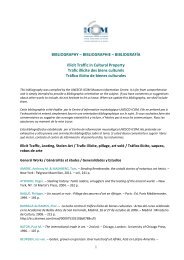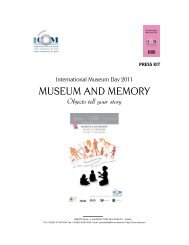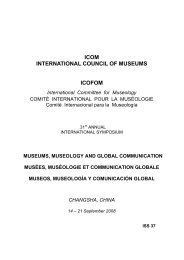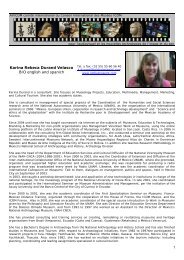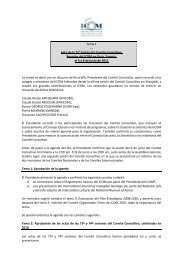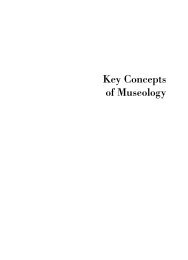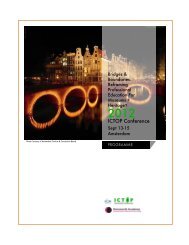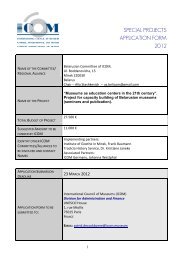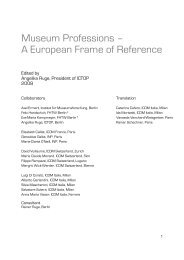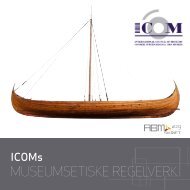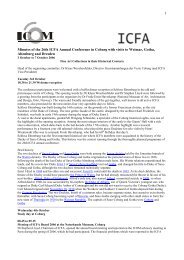ISS 25 (1995).pdf - The International Council of Museums
ISS 25 (1995).pdf - The International Council of Museums
ISS 25 (1995).pdf - The International Council of Museums
Create successful ePaper yourself
Turn your PDF publications into a flip-book with our unique Google optimized e-Paper software.
Gambia National Museum, Banjul 1971). This bias <strong>of</strong> Africanization<br />
resulted in a number <strong>of</strong> regional institutions promoting regional<br />
cultures as for example in Ghana, Kenya and Angola.<br />
Gaining political independence did not result in ec.onomic<br />
independence. Most <strong>of</strong> the African countries retained strong<br />
economic links with the previous colonizers. Some countries like<br />
Zambia or uganda started rich but ended poor. Political<br />
dependence was superceded by an aid dependence. Bi-Iateral and<br />
multi-lateral organizations made their homes allover Africa. In<br />
the thirty years <strong>of</strong> independence, billions <strong>of</strong> dollars were poured<br />
into the development <strong>of</strong> Africa but this did not result in any<br />
improvement <strong>of</strong> the quality <strong>of</strong> life for the great majority <strong>of</strong><br />
people. If anything, the contrast between rich and poor increased<br />
as did the contrast between town and country life. <strong>The</strong> cities<br />
founded in colonial times expanded and are now inhabited by great<br />
numbers <strong>of</strong> unemployed. Uncontrolled migrations from rural areas<br />
to towns created a new phenomenon, the shanty town. Bureaucracy<br />
grew out <strong>of</strong> all proportion and is well known for its<br />
inefficiency. Institutions <strong>of</strong> learning, hospitals and general<br />
infrastructure are run down and in many cases do not function<br />
properly. Economy is in decline, lawlessness has become the law<br />
and corruption is widely accepted.<br />
Generaly, external factors, such as lack <strong>of</strong> capital and<br />
protectionistic economic attitude <strong>of</strong> the West are pinpointed as<br />
being the cause <strong>of</strong> the problem. <strong>The</strong> importance <strong>of</strong> the human<br />
factor, integrity and work ethic are <strong>of</strong>ten underplayed. <strong>The</strong><br />
people in Africa seem not to be particularly interested in<br />
sacrifices which at present could help a great deal to develop<br />
the continent. Many <strong>of</strong> them do not identify themselves with<br />
Africa or even with a country. <strong>The</strong>ir primary interest remains<br />
wi'th their family or with their ethnic group. Technical and<br />
pr<strong>of</strong>essional skills <strong>of</strong> utmost importance in development are not<br />
highly valued as are not maintenance skills. status supercedes<br />
job satisfaction. <strong>The</strong>re is a great concern with education but<br />
better educated people leave easily their jobs or country <strong>of</strong><br />
their origin in search <strong>of</strong> greener pastures. Everybody wants to<br />
be a Director, or even better, a President.<br />
At present (1988) the continent is inhabited by 617,5 mln people,<br />
more or less the population <strong>of</strong> Western Europe 684 mIn) but living<br />
in an area three times bigger (Africa 30,3 mln km2, Europe 9,9<br />
mln km2). While Western Europe can boast <strong>of</strong> approximately 16 000<br />
museums (one museum per 42 750 people), Africa has not more than<br />
SOD (in the most optimistic case it means one museum per 1 235<br />
000 people). Nor is the i_ge <strong>of</strong> .useWlS in Africa very<br />
appealing. <strong>The</strong>y are frequently either under- or overstaffed. All<br />
museum personnel is salaried; museums in Africa run by volunteers<br />
are extremely rare. <strong>The</strong> majority <strong>of</strong> the museums are state run<br />
insti tutions although there are also a few private ones. However,<br />
the Zambian case <strong>of</strong> three national museums and three private<br />
seems to be exceptional. <strong>The</strong> collections are still as they were<br />
in colonial times, predominantly concerned with natural history,<br />
archeology, history and the ethnography. <strong>The</strong>re are very few art<br />
museums, no science museums or other types that developed in<br />
118



